
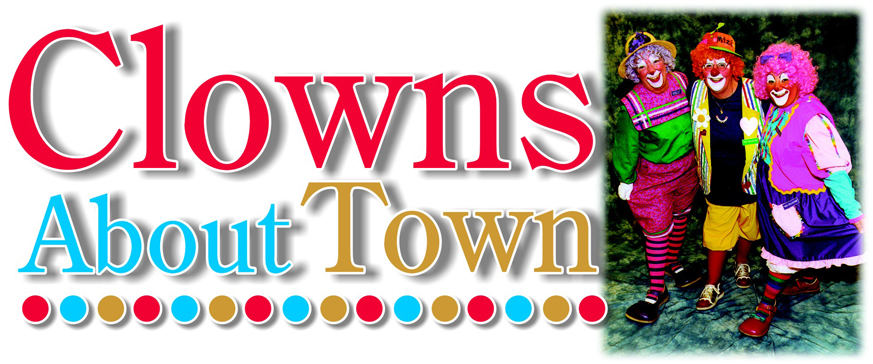
Violet, Mitzi and Giggles, 2005.
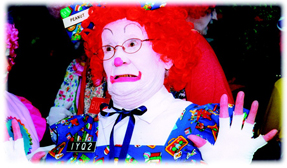
Meet a Trio of WNY Clowns Who
Are Laughing on the Outside and
Caring on the Inside
By Doug Carpenter
It may look simple enough – baggy pants… oversized shoes… perhaps a nice squirting flower on your lapel for added flair – and voila! You’re a clown. Obviously, however, it isn’t that easy. If it were, as they say, anyone could do it.
But not just anyone can be a clown. It takes something special. It takes a big, happy heart and, as you’ll see from the profiles in caring that follow, a motivation to touch the world in a way that enhances both others’ lives and yours.
A Kid Born to
Be a Kidder
If there’s a classic “born to be a clown” story,
Bruce Ruark’s comes pretty close to it. The way he tells it, how
he grew up to become one literally includes the words “When I was
nine, I wanted to run away and join the circus.”
A self-described “Army brat,” Ruark was the oldest of two boys and two girls who, thanks to their Dad’s military career, called places from Alabama, Ohio and Texas all the way to Tokyo, Japan home. But it was on the West coast of Florida that he spent the majority of his grade school years. Specifically in Sarasota, which just happened to be the winter quarters of the famous Ringling Bros. and Barnum & Bailey Circus.
It was also the home of “the Greatest ‘Little’ Show on Earth,” the Sailor Circus, a non-profit organization created in 1949 to offer young people ranging in age from fourth through twelfth grade the opportunity to learn all aspects of the circus, from costuming and props to the flying trapeze and clowning. The experience was also designed to instill valuable life lessons about teamwork, self-esteem and making healthy lifestyle choices.
Fulfillment of that dream, unfortunately, would have to wait, sidetracked by serious auto accident injuries he would sustain shortly thereafter and the many years of recovery that would follow. But even though young Bruce had no way of knowing it at the time, the appeal of the experiences and ideals that that missed opportunity held for him would be a harbinger of important things to come for him personally.
A Chance to “Makeup”
for Lost Time
Many years would pass before clowning would again be an idea whose time
had come for Ruark. But he remembers the exact moment – in 1983
– as vividly as if it were yesterday.
At that time a Recreation Attendant with the Town of Tonawanda Youth Bureau, he was accompanying a group of students and parents on a cruise aboard the Miss Buffalo, the entertainment for which included a performance by clowns from the Shriners organization. That encounter was all it took to rekindle Ruark’s postponed passion and, with the instruction and encouragement of his experienced Master Mason mentors, a clown was born.
By about the sixth month of what was to be a yearlong apprenticeship, Ruark’s new alter ego acquired his first clown “face,” but he still didn’t have a name. That name, and the higher calling that would ultimately make it a name widely known and respected in his community, would come soon enough… and just in time to make an important difference in the lives of the very audience Ruark knew loved clowns best. Kids.
Ruark’s search for an identity to hang his newly acquired big, funny hat on happened to coincide with the expansion of efforts to curb youthful drug abuse through awareness education. And although he was a New York State-licensed Drug and Alcohol Prevention Specialist, that work and his clowning aspirations had, up to that point at least, been unconnected.
But while the “peer pressure resistance” programs being rolled out at the time targeted middle- and high school-age students, Ruark and his Youth Bureau colleagues wondered if it might be even more effective to preemptively reach out to kids at the 1st, 2nd and 3rd grade level when they’re younger and most impressionable. The question was how to do that in a playful, non-threatening way, and the answer was as plain as the big, red nose on Ruark’s face.
Enter “Mr. No, the Professor of Why.”
Happily Taking “No”
for an Answer
The clowning character that Ruark created – who soon came to be
known by enlightened school children and appreciative parents alike as
simply Mr. No – was destined to become a highly visible fixture
on the community landscape. One of the things that fixed him especially
prominently in the public’s awareness were the regular and frequent
appearances he made at school assemblies and community events, a large
portion of them as part of an aggressive anti-substance abuse/pro-self-esteem
education effort in the Ken-Ton schools.
“The community just grabbed hold of the whole thing and thought it was a super idea,” Ruark recalls, at which point Mr. No “took on a life of his own.” By the time the program had peaked some 14 years later, the scope of what its presentations would address had expanded to engage students not just on drugs but about equally potent issues like smoking and prescription medications.
During what he modestly calls “a great run” as the clowning “face” of a campaign that positively influenced the lives and values of a generation of youngsters – many of whom, he says, now bring their children to his appearances – Ruark’s costumed persona spawned a variety of popular Mr. No paraphernalia, including Mr. No buttons, Mr. No “pogs” and three different Mr. No coloring books.
And should he need any reminding of how the lives he touched might be different had there never been a Mr. No in the picture, he need only think about the page from one of those books… all colored in by an obviously enthusiastic and undoubtedly more safety-savvy young artist… that still hangs proudly, framed for posterity, on the wall of one of the Town’s recreation centers.
Turning from
“No” to “Y.E.S.”
For its part, the community and its civic organizations are well aware
of the importance of Ruark’s contributions, having honored him for
his much-valued and respected service many times over the years. For some
people, that would be more than enough to give them a rewarding sense
of accomplishment, as it would for Bruce Ruark… if his story ended
there.
In his current role as Youth Programs Administrator for Tonawanda’s now-combined Department of Youth, Parks and Recreation, a large part of Ruark’s job is supervising the Town’s Youth Centers and running its Y.E.S. Program, which stands for Youth Engaged in Service. In all of his work with young people, he places a strong emphasis on helping them develop the “personal assets” they need to create a positive future.
He smiles as he notes how in many ways the ideals the program stresses to the older teens convey the same message that Mr. No brought to their younger counterparts two decades earlier: the value of teamwork, the benefits of self-esteem and the importance of making healthy lifestyle choices.
If those sound familiar, they should. Ruark may not have gotten to be part of the Sailor Circus, but its values clearly became part of his.
Once a Clown,
Always a Clown
Now well into his third decade practicing the noble if somewhat whimsical
art of clowning, Ruark has gradually taken his Mr. No show on the road
less often in recent years. Not that he hasn’t covered some pretty
significant ground up til now in a career that has taken him not just
all over Western New York but to internationally-attended clown conferences
and training sessions, like the national Clown Camp, held annually in
La Crosse, Wisconsin.
But regardless of where his life may take him – either in or out of character – Bruce Ruark knows without any doubt that he will always be Mr. No. That’s because he recognizes that “This wasn’t really something I chose. It chose me.”
“I truly believe that you’re called to do certain things in life,” he says. “And what I was called to do was work with kids, and,” he adds with now deeply-rooted certainty, “to do it through clowning.” In fact, he goes so far as to say that it almost doesn’t matter anymore whether he’s in or out of costume. People who know him, either as Mr. No or Bruce Ruark, always see “the same regular, everyday kind of guy” he is… well… every day.
At age 57 with literally thousands of appearances behind him – including everything from stock-in-trade gigs like birthday parties, picnics and parades to corporate receptions, black-tie galas and, yes, even the occasional bachelorette party – Ruark envisions his clowning days stretching on indefinitely, well beyond any approaching retirement.
Because whether he’s decked out in his bright, bushy wig and big, red nose or simply being Bruce, Ruark knows that he’s been given a very special gift. The ability, the opportunity and, he is very quick to point out, the privilege of touching people’s lives and changing them for the better with a brief moment of joy they otherwise might not have known.
In the face of something that rare and magical, there’s really only one question he can think to ask. “If I can do something that creates 99 smiles and always leaves me with one of my own, how could I possibly walk away?”
A Violet Grows
in Clown Alley
When she’s “in clown,” Sue Spindler calls herself “Violet.”
But with her outlook on life, she could just as easily have gone with
“Rainbow” or “Sunshine.” Some people just seem
to have a knack for seeing the bright spots in a dark sky, and she’s
one of them. It’s a gift she puts to very good use, too. She just
wasn’t expecting to do it as a clown… certainly not when there
were so many other things on her “list.”
We all have one. A master “To Do” list. Whether it’s actually written down or just filed away somewhere in the back of our minds, we know exactly what the things are that we’d really love to try or in fact seriously intend to do when we “have time.” Life being the way it is, of course, that last part frequently ends up being after we retire.
And so it was with Sue, for whom “becoming a clown” was not exactly #1 among the things she was looking forward to when retirement finally gave her the freedom to indulge herself. Working in a flower shop? Possibly. Cleaning out her basement… finally? You bet. But putting on what amounts to multi-colored pajamas, oversized shoes and an arguably silly-looking hat with flowers sprouting from the top? Not so much.
That, however, was before a copy of the Maryvale Schools Continuing Education catalogue appeared in her mailbox. In it, along with the usual classes on how to write a killer resume or grow an herb garden was listed a most intriguing class for people interested in becoming a clown. She figured “What the heck. The basement can wait.”
Time Flies When
You’re Having Fun
That was 11 years ago, and though her basement mess has yet to be tackled,
she couldn’t be more tickled about the choice she made. Because
it opened up for her a whole world of experiences and emotions that she
would have missed entirely had she subscribed to the theory […no
doubt invented by people who don’t have enough fun…] that
grownups are required to always act “grown up.”
If that were true, one quickly comes to realize, we wouldn’t have any clowns. Certainly not Violet, the person who emerged when the outer Sue Spindler discovered that her inner child really liked dressing up funny and making people laugh.
Having her life changed by taking a class was an interesting turnabout for a person who had just retired after having herself taught for 33 years. But as a freshly-minted student clown at 57, she was the first to realize that she had a lot to learn.
That first class, much like the supplemental training sessions she’s attended in subsequent years, imparted not just the nuts and bolts aspects of clowning – things like makeup, balloon sculpture-making and face painting – but also clowning’s history, values and even psychology – like how to handle a heckler. [The #1 rule? Don’t lose your cool.]
Funny Is As
Funny Does
Over the years, as Violet has developed into her own person, Sue Spindler
has found as very special and welcoming place for both of her personas
in a community of like-minded individuals… some of them clowns like
her and some of them “civilians” with similarly big hearts.
Not surprisingly, they are in many ways much like a big, extended family.
In addition to serving as Business Manager for Buffalo’s Clown Alley, a professional organization for area clowns […which, despite being nearly 30 years old, will probably not be acting grown up any time soon, thank you very much,] she is also part of a group called W.O.W. Short for Wacky on Wednesdays, it’s a traveling troupe of clowns that brings humor to places like senior centers and skilled nursing facilities from January through May of each year.
Her belief in the power of humor has also led her on a continuing quest to more fully understand it. These have included attending national conferences like the one sponsored by the Humor Project keynoted by international stress and humor consultant Loretta LaRoche, well known from her frequent appearances on Public Television.
And for sheer, raw clown humor power, she says, there was nothing quite like the experience of seeing more than 500 clowns from all over the world all in one place and all in full clown regalia… something she experienced while attending a recent meeting of the International Clown Association in Saratoga Springs.
More evidence that student clown Violet learned her lessons well is her involvement with another group – this one appropriately named HAHA of WNY. A non-profit alliance of people in professions ranging from teachers and writers to grief activists and, yes, clowns, it takes a multi-disciplinary approach to the creative use of humor to promote physical, mental and emotional health.
A “Kiss” for
Where It Hurts
Sometimes, however, one person alone can make a bigger difference than
a hundred working together. It’s something Sue Spindler realized
very shortly after she became Violet when she began making volunteer cheer
visits to Buffalo’s Roswell Park Cancer Institute more than a decade
ago.
Susan Siegel, RPCI’s Director of Volunteer Services, has known both Violet and Sue Spindler for the better part of six of the nearly 11 years “they’ve” been coming in to entertain, encourage and otherwise brighten up the day for children and adults alike who receive treatments at Roswell.
“She’s a regular fixture,” Siegel says, “coming in every Tuesday for at least four or five hours. And since many of our patients also come in for chemo, blood or radiation on the same day each week, the bond she’s been able to form with many of them makes it that much easier for her to give them what they need most – comfort and hope.”
She also gives them a sweet, little something extra. A kiss… Hershey’s, that is. The popular chocolate morsel has become both Violet and Sue’s trademark, dispensed with a mood-lifting charm that Susan Siegel has seen lift some of the weariest hearts.
The fact that she has so generously given of herself, Siegel adds – both for what is now nearly 1,900 hours as an individual volunteer as well as numerous additional fundraising appearances as Violet – “is just a small part of what makes her so unique and so very special to us.”
To Be, or Not
to Be, Violet
Even though she still wears a pin that says “Plain Clothes
Clown” when she’s not dressed as Violet, over the years Sue
Spindler has actually come to do much of what she does not in costume.
But it just goes to illustrate yet again how much becoming a clown can
influence the person you are when you’re not clowning,
Very early on, Violet had a moment of self-discovery very similar to one that Bruce Ruark made about himself and Mr. No. She realized that when it comes to touching people’s lives, it doesn’t really matter whether you’re wearing makeup and a costume or not. If you’re meant to make a difference, you will.
Clearly, she was… and she does.
Funny Things Come
in Small Packages
And finally, one more little story about a clown with a very
small name who invariably makes a very big impression on everyone
who meets her. Her name is “Peanut,” and let’s get one
small but very impressive detail about her on the record right up front.
By the time many of you read this, Peanut […or Betty Tresselt, if you insist on being all grown up…] will have celebrated her 90th birthday. And she still clowns. You really can’t blame her for not wanting to stop, of course. After all, she didn’t start until she was 70.
For Betty, choosing the name Peanut was no big stretch, since it was exactly what her family had affectionately called her all her life. That probably explains why they were so supportive when this colorful character emerged from this soft-spoken lady.
“Peanut” Comes
Out of Her Shell
Betty Tresselt was born in 1918 – the year before the Ringling Bros.
and Barnum & Bailey Circuses combined to officially form the fabled
“Greatest Show on Earth.” She had been retired from her job
as secretary to the Superintendent of the Cleveland Hill Schools for 12
years before clowning caught her eye.
That nobody in her family batted a single one of theirs at the thought of the wife and mother of two “dressing up funny” and “acting silly” tells you that she and clowning must be a pretty natural fit, as was the costume she would ultimately wear to become Peanut. Then again, it should, considering that she made every beautiful, multi-colored inch of it herself.
The traditional “big clown shoes,” though, were another matter. But what it has cost her to pursue her dream, she points out with pride, has been small compared with what she’s gained from experiencing the joy it has brought to those for whom she’s had the pleasure and privilege of performing for nearly 20 years.
It’s All Downhill…
in a Good Way
Besides, she says, if being a clown won’t keep you young at heart,
what will? In her case, it might be skiing, which even today she still
does an average of three times a week as a member of the Buffalo Ski Club
during Western New York’s usually abundantly snowy Winters.
Of course, the fact that she’s been doing it since even before she and her husband of more than 50 years got married means that the slope is probably the one place she doesn’t clown around. She saves that behavior for opportunities like getting together with her fellow funsters from Buffalo Clown Alley for their annual August 1st through 7th celebration of National Clown Week, traditionally marked by a group appearance at downtown Buffalo’s M&T Plaza.
Between her relationship with Clown Alley and the positive reputation any clown worth a giggle inevitably earns if they do what they do with love, she says that she’s kept plenty busy over the years. But like her clowning compatriots Mr. No and Violet, she modestly concedes that she never really did it for the money. How could it be about that, she asks, when laughter is the most golden thing in the world?
With the understandable uncertainty of how well something as inherently “low-tech” as clowning will fare in the high-tech, cyber-swift world of the 21st century, we’ll simply have to hope and wait to see if another generation of big, happy hearts steps up to follow in the caring footsteps of classy clowns like Mr. No, Violet and Peanut.
Of course, if they do, they’ll certainly have some pretty big shoes to fill.
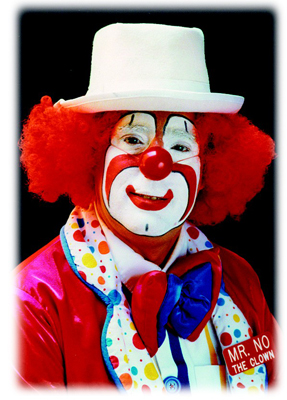
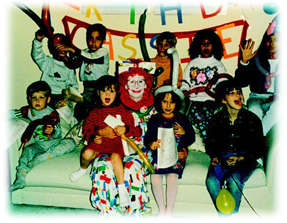
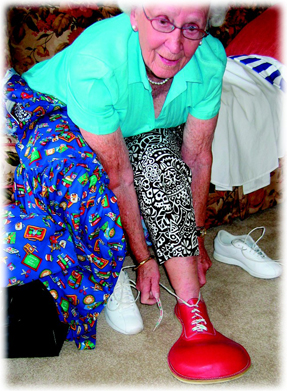
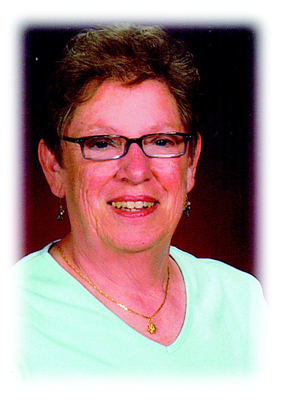
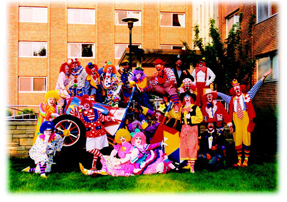
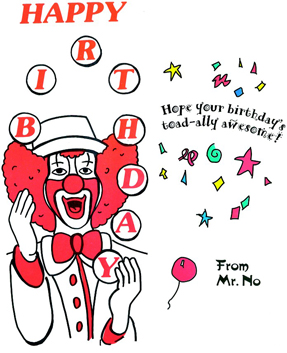

A newspaper for Western New York's Seniors - and proud of it!